Review
Jul 21, 2022

Te Pou Herenga Waka O Rehua
Nā Claire Kaahu White
Te Whatumanawa Maoritanga O Rehua Trust Board
$40.00 + postage
(only available through Rehua Marae)
Review nā Paula Rigby
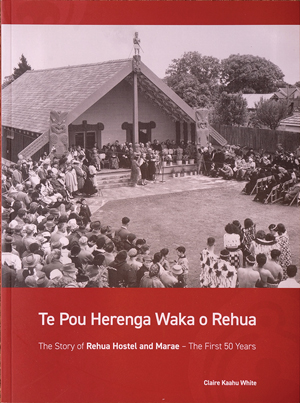 The long-anticipated book about Rehua is finally available. A labour of love written by Claire Kaahu White working closely with Dr Terry Ryan, the book has 16 chapters and 335 pages. If you were looking at a comprehensive story about Rehua you may be disappointed and the title is a little misleading. As the book covers not only Rehua Marae, but Māori Affairs Trade Training in Christchurch, the different hostels and key moments and people that were influential in the development of both the trade training scheme and Te Whatumanawa Maoritanga O Rehua Marae through the first 50 years.
The long-anticipated book about Rehua is finally available. A labour of love written by Claire Kaahu White working closely with Dr Terry Ryan, the book has 16 chapters and 335 pages. If you were looking at a comprehensive story about Rehua you may be disappointed and the title is a little misleading. As the book covers not only Rehua Marae, but Māori Affairs Trade Training in Christchurch, the different hostels and key moments and people that were influential in the development of both the trade training scheme and Te Whatumanawa Maoritanga O Rehua Marae through the first 50 years.
For a historical publication it is an enjoyable read, the narrative is easy to follow and full of interesting information. It is accompanied by an amazing collection of photographs and is interwoven with anecdotes and interviews from past residents and staff not only of Rehua but the other Trade Training Hostels that were part of shaping the fabric of Christchurch city.
 Paula Rigby (Ngāi Tahu, Ngāti Kahungunu, Ngāi Tūhoe, Ngāti Ruapani) is a current trustee of the Rehua Marae Trust. She is the daughter of a Rehua Old Boy who went through the Māori Affairs trade training scheme. Paula was also a trade trainee and was a resident of Te Kaihanga Hostel. Through her father’s association with Rehua, Paula grew up with the marae as part of everyday family life.
Paula Rigby (Ngāi Tahu, Ngāti Kahungunu, Ngāi Tūhoe, Ngāti Ruapani) is a current trustee of the Rehua Marae Trust. She is the daughter of a Rehua Old Boy who went through the Māori Affairs trade training scheme. Paula was also a trade trainee and was a resident of Te Kaihanga Hostel. Through her father’s association with Rehua, Paula grew up with the marae as part of everyday family life.
Me Anga Whakamua – Facing the Future
Nā Janet Hetaraka Raua
ko Diane Stoppard
Published by Hihiaua Cultural Centre Trust, Whangarei 2021
RRP: $49.99
Review nā Maatakiwi Wakefield
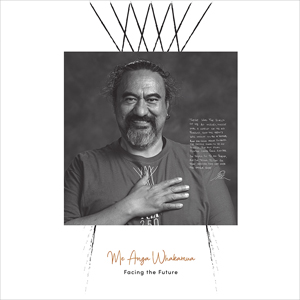 “The ties that bind us as a people, as a nation, are woven from the threads of whakapapa, of a shared history of a vision for a brighter future.” Kawiti Waetford
“The ties that bind us as a people, as a nation, are woven from the threads of whakapapa, of a shared history of a vision for a brighter future.” Kawiti Waetford
2019 marked the sestercentennial (250th anniversary) of the first ‘formal’ encounters between Māori and Pākehā in Aotearoa. Under the banner of Tuia 250, a number of events were held throughout the country to mark these auspicious occasions. One such event was held at Hihiaua Cultural Centre, Whangārei where the mauri of this book was born through images captured by Diane Stoppard (Pākehā) and reflections compiled by Janet Hetaraka (Kāi Tahu, Kāti Mamoe, Waitaha).
Beginning its life in 2020 as a photographic exhibition of those images and reflections, Me Anga Whakamua – Facing the Future is a beautiful immortalisation of Stoppard’s images, woven together with aspirational reflections provided to Hetaraka from a cross section of the Whangārei community. While neither woman is from Tai Tokerau, each has spent a large part of their lives within the Whangārei community. This provides each woman with a unique refreshing objectiveness with understanding which is reflected in their work.
Essayists Te Warihi Hetaraka, Alison Jones and Justice Hetaraka provide insightful introductory narrations highlighting the importance of this moment in time to Māori and Pākehā, old and young. An aspirational thread of hope and belief of growing a shared future together while remembering our shared heritage, runs throughout each of the reflections that accompany Stoppard’s striking images.
While this book is based in Whangārei, Tai Tokerau, the conversation it ignites belongs to the nation – our shared future, acknowledgment of our shared heritage and unique culture. Me Anga Whakamua – Facing the Future is an easy, enjoyable read. It is an inspirational collection of aspirational reflections for our future cleverly woven together to accompany these compilation of images. It is a recommended read for all ages and ethnicities – enjoy, I did.
 Maatakiwi Wakefield (Waitaha, Kāti Māmoe, Kāi Tahu, Ngāti Mutunga, Te Āti Awa, Ngāti Toa) is Kaitakawaenga Māori for the Christchurch City Council Library Services, and a contractor with Te Rūnanga o Ngāi Tahu.
Maatakiwi Wakefield (Waitaha, Kāti Māmoe, Kāi Tahu, Ngāti Mutunga, Te Āti Awa, Ngāti Toa) is Kaitakawaenga Māori for the Christchurch City Council Library Services, and a contractor with Te Rūnanga o Ngāi Tahu.
The Māori Picture Dictionary/Te Papakupu Whakaahua
Nā Ross Calman, Margaret Sinclair, Josh Morgan, Isobel Joy Te Aho-White
Picture Puffin
RRP: $30.00
Review nā Ila Couch
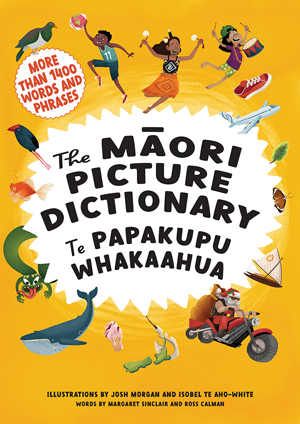 No matter where you, or your whānau are in your reo Māori haerenga, building vocabulary is essential. Every day brings an opportunity to add a new kupu to the kete kōrero which is where Te Papakupu Whakaahua comes in handy. With over 1400 illustrations of kupu that pop up in daily life, The Māori Picture Dictionary is perfect for visual learners, and a tangible, tactile tool for mātua, or tāua and pōua to engage tamariki with.
No matter where you, or your whānau are in your reo Māori haerenga, building vocabulary is essential. Every day brings an opportunity to add a new kupu to the kete kōrero which is where Te Papakupu Whakaahua comes in handy. With over 1400 illustrations of kupu that pop up in daily life, The Māori Picture Dictionary is perfect for visual learners, and a tangible, tactile tool for mātua, or tāua and pōua to engage tamariki with.
Alongside an A-Z assortment of illustrated kupu Māori, are full-page drawings laying out scenes that put the reader inside a home, classroom and marae. Themed word lists covering the basics like days of the week, months, numbers, colours, shapes and major cities in Aotearoa are also included, as well as an index of Māori to English words. Language reclamation can be fun.
For example, picking a new kupu from Te Papakupu Whakaahua and using that word throughout the day – say tūru instead of chair – would be a great way of accessing this resource on a daily bais. Chances are you will not only add to your own vocabulary but be contributing to someone else’s.
 Ila Couch (Ngāi Tahu – Te Hapū o Ngāti Wheke) is a multimedia producer, writer, and filmmaker based in Ōtautahi.
Ila Couch (Ngāi Tahu – Te Hapū o Ngāti Wheke) is a multimedia producer, writer, and filmmaker based in Ōtautahi.
Matariki Around the World: A Cluster of Stars, a Cluster of Stories
Nā Rangi Matamua & Miriama Kamo, with Isobel Joy Te Aho-White
Scholastic NZ
RRP $34.99
Review nā Hannah Kerr
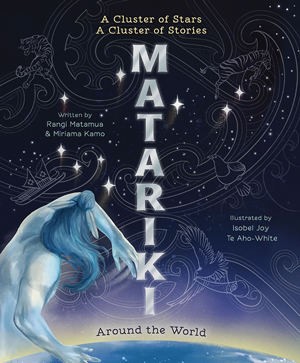 Matariki Around the World: A Cluster of Stars, a Cluster of Stories is a beautifully told and illustrated book that I wish I had as a young child. Even though it is aimed at tamariki, I think every adult should read it, as it is a pukapuka taonga brimming with stories about Matariki from Aotearoa and around the world.
Matariki Around the World: A Cluster of Stars, a Cluster of Stories is a beautifully told and illustrated book that I wish I had as a young child. Even though it is aimed at tamariki, I think every adult should read it, as it is a pukapuka taonga brimming with stories about Matariki from Aotearoa and around the world.
Written by Miriama Kamo (Ngāi Tahu, Ngāti Mutanga) and Rangiānehu ‘Rangi’ Matamua (Tūhoe), and illustrated by Isobel Joy Te Aho-White (Ngāi Tahu, Ngāti Kahungungu ki Wairoa). The timing of this pukapuka coincides well with our celebration of Matariki as a public holiday for the first time. This pukapuka is a must-have for all whānau across the motu. It begins by telling the story of Ranginui and Papatuanuku and how Mataraiki was born when Tāwhirimātea crushed his eyes in his hands and threw them into the sky as a sign of love and defiance for his father. We then follow the story as the authors detail to us the nine named whetū and the roles they play.
Ngā Mata o te Ariki Tāwhirimātea or Matariki for short is our name for the star cluster, but there are dozens of stories and names that exist across our globe. In Japan it is called Subaru, in Tahiti it is known as Matari’i and Freyja’s Hen’s in Scandinavia. The amount of stars in each story also varies, (even in Aotearoa!). Iwi acknowledge seven or nine whetū, across the globe while other cultures acknowledge six, seven, nine or even twelve!
What this pukapuka does so well is gifting the reader an incredible amount of information about Matariki, but it never makes you feel like you are being oversaturated or reading an essay. Tamariki will be able to read and understand the knowledge embedded in the pages. The writing effortlessly and simply tells us the stories from cultures across the globe, and weaves in the magical illustrations from Isobel Te Aho-White, Matariki: A Cluster of Stars, a Cluster of Stories.
Growing up my father would get us up at 5am every year in the middle of winter to see if we could see Matariki rising in the night sky. A lot of the time thanks to the clouds above Karitane and Ōtepoti it would take three or four nights in a row before we actually saw it! Even at a young age I knew this moment was special and marked a new beginning, a time for refreshing and being with whānau. This book made me feel more connected to my whakapapa learning how vital Matariki was in guiding our ancesters across Moana-nui-a-kiwa (Pacific Ocean) to Te Waipounamu, and then how once they lived on the whenua they used the rising of the star cluster to acknowledge the start of a new year. I hope that the generations after me will know these stories from a young age and that it won’t take them two decades to learn the names of the whetū. I also hope that this moment of Aotearoa collectively acknowledging Matariki will inspire more of us to share the knowledge we have about our iwi and their stories.
As Rangi Matamua’s Koko (grandfather) used to say ‘Knowledge that is not shared is not knowledge.’
 Hannah Kerr (Kāi Tahu, Kāti Mamoe, Waitaha – Kāti Huirapa ki Puketeraki, Ngāti Wheke) lives in Ōtepoti, Dunedin and is currently a writer and editor for the Communications team at Te Rūnanga o Ngāi Tahu, working on Te Pānui Rūnaka and Te Karaka magazines. Hannah has a passion for writing and loves reading in her spare time. She has a degree in History and is keen to learn more about our Kāi Tahu stories and her own whakapapa.
Hannah Kerr (Kāi Tahu, Kāti Mamoe, Waitaha – Kāti Huirapa ki Puketeraki, Ngāti Wheke) lives in Ōtepoti, Dunedin and is currently a writer and editor for the Communications team at Te Rūnanga o Ngāi Tahu, working on Te Pānui Rūnaka and Te Karaka magazines. Hannah has a passion for writing and loves reading in her spare time. She has a degree in History and is keen to learn more about our Kāi Tahu stories and her own whakapapa.
Nuku: Stories of 100 Indigenous Women
Nā Qiane Matata-Sipu
QIANE+CO
RRP: $65
Review nā Ila Couch
 Qiane Mata-Sipu (Te Waiohua ki Te Ahiwaru me Te Akitai, Waikato, Ngāpuhi, Ngāti Pikiao and the Cook Islands) may have written Nuku: Stories of 100 Indigenous women for her kotiro Haeata te Kapua but she has produced a treasured collection of love letters to all wāhine taketake.
Qiane Mata-Sipu (Te Waiohua ki Te Ahiwaru me Te Akitai, Waikato, Ngāpuhi, Ngāti Pikiao and the Cook Islands) may have written Nuku: Stories of 100 Indigenous women for her kotiro Haeata te Kapua but she has produced a treasured collection of love letters to all wāhine taketake.
Part of a multimedia project, Nuku condenses into short chapter interviews conducted for the podcast series of the same name. Qiane cast the net wide, speaking to a diverse group of 100 indigenous women from pioneering wāhine Māori in their fields (a RNZAF pilot, patent attorney, purfumerier), taitamariki running their own businesses at the ages of 14 and 16, to indigenous women from Mexico, Hawai’i and South Asia. In bringing these voices together (accompanied by stunning portrait photography) what is revealed are the common threads that unite wāhine taketake worldwide; the importance of our tūpuna, healing ourselves and future generations through the reclamation, revitalisation and celebration of language and culture, and our enduring connection to Papatūānuku – this one planet we inhabit.
The mahi it took to get this self-published book made should also be acknowledged as the writing, photo editing and design of this pukapuka overlapped with pre, and post production of the podcast, multiple funding application deadlines, and the full-time job of being a parent.
Qiane Mata-Sipu wrote this to her daughter. “Indigenous wāhine are world leaders, world makers and world changers. Don’t let anyone tell you otherwise.” Nuku is a much needed affirmation of that truth.
Uprising: Walking the Southern Alps of New Zealand
Nā Nic Low
Text Publishing
RRP: $40.00
Review nā Ila Couch
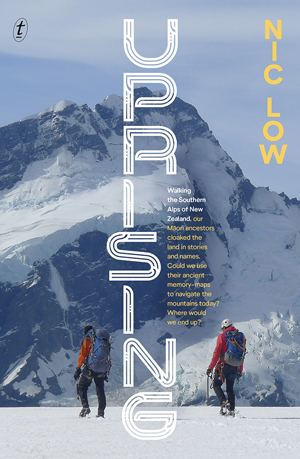 Nic Low (Ōraka-Aparima, Awarua, Puketeraki) spent a decade researching and writing Uprising: Walking the Southern Alps of New Zealand.
Nic Low (Ōraka-Aparima, Awarua, Puketeraki) spent a decade researching and writing Uprising: Walking the Southern Alps of New Zealand.
Nic establishes his deep connection to the Southern Alps through his Māori and Pākehā whakapapa; starting on his European side with a story of how, in 1902, a party of 20 Lows travelled in horse-drawn wagons to visit Aoraki (Mount Cook), to his earliest memory of his first overnight tramping trip in Arthur’s Pass National Park with his dad and brothers at the age of 9. On his mother’s side, Ngāi Tahu, Kāti Māmoe and Waitaha, land is viewed through the lens of whakapapa. “People didn’t discover places … they created, became, are, the land.”
Giving a brief overview of Ngāi Tahu history – origin stories, colonisation, dispossession, seven generations of tribal activism, settlement and the successes of a modern iwi – Nic shares an intimate family story of intergenerational trauma and language loss, described so vividly you might just cry … and that’s just the introduction.
Nic crossed Kā Tiritiri-o-te-Moana more than a dozen times in the process of writing this book and each chapter begins with the introduction of a new or recurring character who physically made those journeys with him – family, friends, colleagues. Unfolding along the way are stories from the past, meticulously researched with the help of Ngāi Tahu historians, educators and Low’s own whānau. Before gathering them together for this book, most of these stories were spread across several key books, manuscripts, or in people’s heads. The idea was to put them back on the landscape. Uprising is a book the author hopes readers will take with them, to read in the places they have been written about.
Historically, there is a lot to learn but that information is never imparted in a way that feels burdensome. Nic’s skill as a writer is being able to weave together the past and present through conversations with his travel companions and the acts of walking, foraging for kai and interacting with the natural world. He also imagines for us a world where Treaty promises are honoured and instead of trespassing on our own lands, we are surviving and thriving.
Uprising is not an easy book to sum up in a few words, but I find myself telling people to read it for that reason. It is deeply personal, poetic and full of adventure tales. As Ngāi Tahu we are so fortunate to have a kaituhi with such talent, dedication and passion in the craft.
Tāngata Ngāi Tahu: People of Ngāi Tahu (Volume Two)
Edited by Helen Brown
and Dr Michael J. Stevens
Te Rūnanga o Ngāi Tahu and Bridget Williams Books 2022
RRP: $39.99
Review nā Anna Brankin
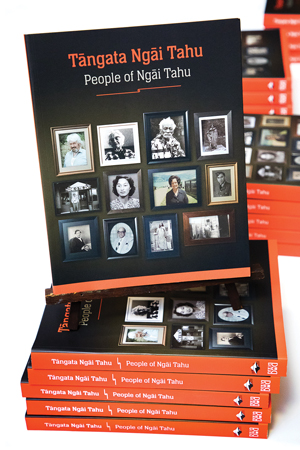 This beautiful pukapuka is the second in a series of publications featuring the stories of notable Ngāi Tahu whānau members, past and present. Published in 2017, Volume One comprised 50 biographies with the promise of more to come; Volume Two makes good on that promise with 50 more. Furthermore, the opening pages of the book tell us that the planning for this volume coincided with the 125th anniversary of women’s suffrage in Aotearoa, and as such 28 out of the 50 biographies are of women. As Tā Tipene O’Regan writes in his foreword: “Carefully chosen to pay tribute to some of our most valued taua, hākui and tuāhine, this collection of biographies offers inspiring role models for our daughters and granddaugthers: he rakatira mō āpōpō!”
This beautiful pukapuka is the second in a series of publications featuring the stories of notable Ngāi Tahu whānau members, past and present. Published in 2017, Volume One comprised 50 biographies with the promise of more to come; Volume Two makes good on that promise with 50 more. Furthermore, the opening pages of the book tell us that the planning for this volume coincided with the 125th anniversary of women’s suffrage in Aotearoa, and as such 28 out of the 50 biographies are of women. As Tā Tipene O’Regan writes in his foreword: “Carefully chosen to pay tribute to some of our most valued taua, hākui and tuāhine, this collection of biographies offers inspiring role models for our daughters and granddaugthers: he rakatira mō āpōpō!”
At over 400 full-sized pages, it is not a book to be consumed in one sitting. It has sat on my bedside table for the past few weeks and I have delighted in picking it up at intervals and selecting an entry at random. Each entry is accompanied by photos, drawings and portraits that contribute to a much deeper understanding of the whānau members they represent.
There is equal pleasure to be found in reading the biographies of people I knew personally, and in learning about the life of those I never met. When I first opened the book and perused its contents page, I was immediately drawn to the biography of Jane Ruby Karina Davis, or Aunty Jane. Having known Aunty Jane for many years before her passing in 2019, it was wonderful to read more about her life, nodding with familiarity in some parts: “Though small in stature and softly spoken, she had a reputation as a strong leader with a sharp mind”, and discovering new things about her in others: “Jane was also involved in the local horseracing scene and at one stage had aspirations to become a jockey.”
On another occasion, I stumbled across the biography of Emily Jane Hannah Rawei, who lived from 1873–1939 and had a vibrant international career as an entertainer. More commonly known as Jean, she and her husband Francis Rawei performed across Australia and America. “A typical show comprised lectures on ‘the peculiar habits, strange customs and superstitions of the Maoriland natives’, interspersed with singing in both te reo Māori and English.” Later in life, Jean was a regular contributor to American newspapers, sharing her views on everything from politics to the fashions of the day.
These are just two of the informative and absorbing biographies that make up Volume Two of Tāngata Ngāi Tahu. The intricate detail of each story is a testament to the exhaustive research carried out by the 25 writers who have contributed to this publication. It is truly a book to be proud of, and a magnificent addition to the bookcase of any Ngāi Tahu household.
 Anna Brankin (Ngāi Tahu – Ōraka Aparima) is the Chief of Communications at NAIA, a consultancy that supports Māori organisations with their strategic and communications needs. She is also a freelance writer and avid reader.
Anna Brankin (Ngāi Tahu – Ōraka Aparima) is the Chief of Communications at NAIA, a consultancy that supports Māori organisations with their strategic and communications needs. She is also a freelance writer and avid reader.
Opinions expressed in REVIEWS are those of the writers and are not necessarily endorsed by Te Rūnanga o Ngāi Tahu.